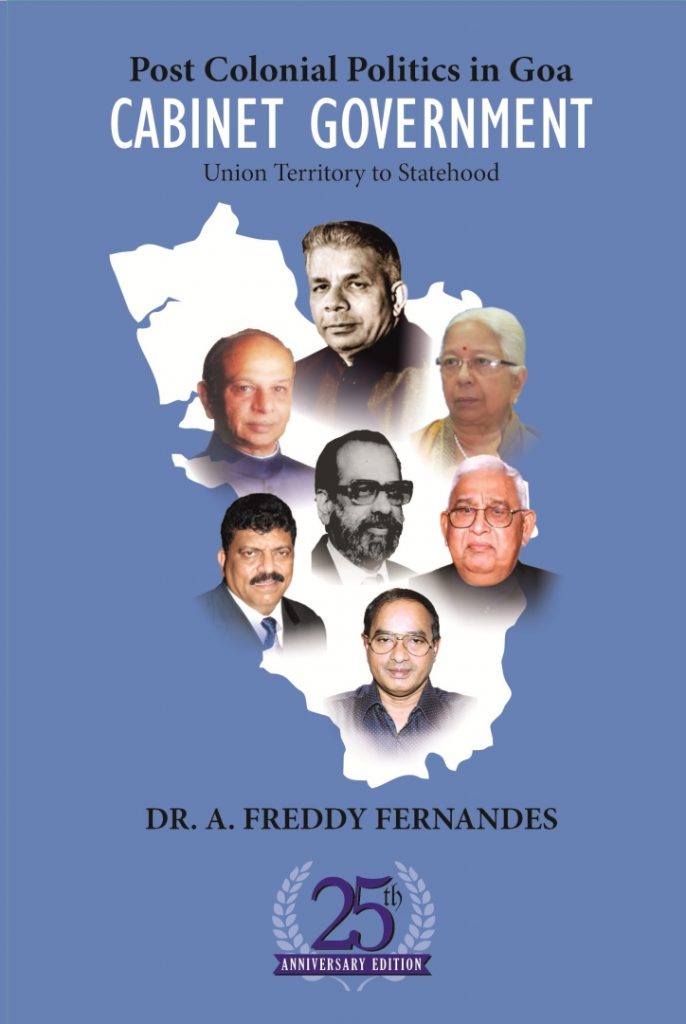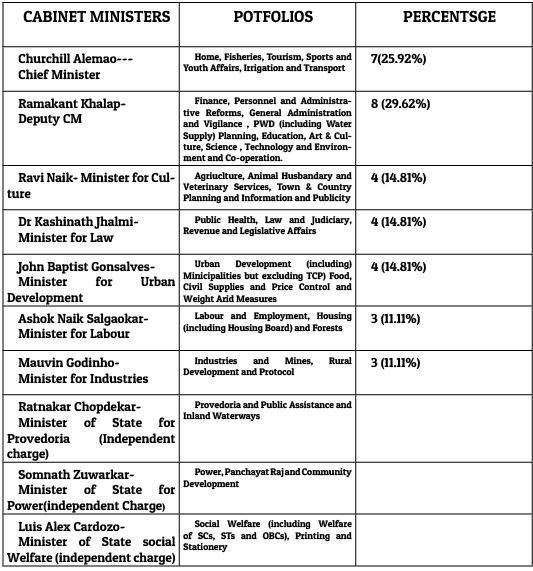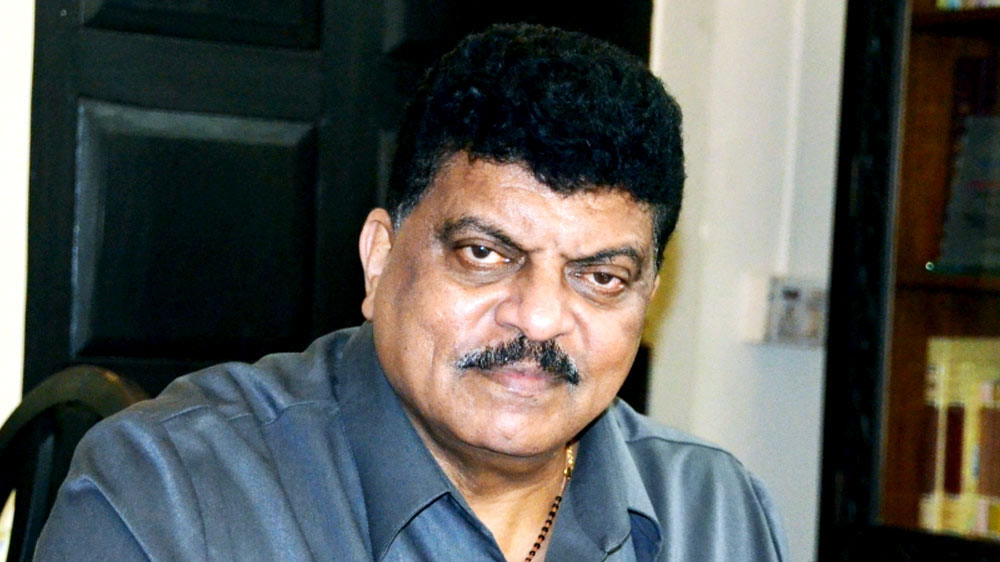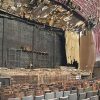Goa is abuzz with excitement as vintage bike and car owners, users, collectors and fans are decking […]

CHURCHILL ALEMAO: 17-DAY CHIEF MINISTER OF GOA!
Book, June 21- June 27, 2025 June 20, 2025(27 March 1990 to 13 April 1990)
Tribute to the second chief minister of the State of Goa Mr Churchill Alemao, affable and good hearted CM.
(Born 16 May 1947, Carmona, Goa)
(Courtesy `Post Colonial Politics in Goa, CABINET GOVERNMENT, Union territory to statehood’ by Dr A Freddy Fernandes, 25th anniversary edition, published by CIVITAS 2025, hardcover.)
INTERIM CABINET FORMATION
THE original plan of the rebels was, that once the Rane government was toppled, Barbosa would resign as Speaker and get elected as leader of the PDF government and take over as CM. However, there was a serious hitch in this plan. The moment Barbosa stepped down, Simon D’Souza, as deputy speaker, would proceed to disqualify all the seven rebels thereby creating an unprecedented constitutional crisis. To avoid such a contingency, the rebels came up with an ingenious plan—that of setting up an interim cabinet.
Churchill Alemao was to be sworn-in as interim Cm (although opposed by MS prabhu and AN Naik of the major coalition partner, the MGP). Khalap was unacceptable to the Shashikala Kakodkar faction within the MGP, while JB Gonsalves on whom the MGP had agreed, was unacceptable to Farrel Furtado and GPP.
Goa’s first catholic chief minister
Churchil Alemao was therefore sworn-in as Goa’s first Catholic chief minister and first interim chief minister on Gudi Padva on 27th March 1990, at 8:45am, along with a nine member cabinet. At the hurriedly decided ceremony Deputy CM Ramakant Khalap, Ravi Naik, Ashok Naik Salgaonkar (all MGP), JB Gonsalves and Mauvin Godinho (both GPP) were sworn in as cabinet ministers, while Ratnakar Chopdekar (MGP), Somnath Zuwarkar, Luis Alex Cardozo (both GPP) were designated ministers of State. Kashinath Jhalmi was sworn-in an hour later as he was informed of the ceremony that morning itself and arrived late at the Raj Bhavan.
All PDF members were present except Independent AN Naik, MGP, MLAs Mohan Amshekar and Ranu Prabhudesai. The Congress MLAs boycotted the function, but the Rajya Sabha MP John Fernandes was the only Congressman present. In a populist move, flaunting the garb of communal harmony, the ministers visited the Mhalsa temple, Mardol and Bom Jesus Church at Old Goa, after the swearing-in. They also visited the Bandodkar (MGP doyen) Samadhi at Miramar, Panajim, before the swearing in, probably to get the backing of MGP supporters.
Shashikala Kakodkar said she was neither offered nor would she accept any position in the new ministry, offsetting speculations that she would heed Congress’s overtures to cross over with some MLAs. To avoid this Khalap announced a second cabinet expansion to include another two of three ministers in the already unwieldy cabinet. He declared that MGP had joined the ministry (a virtual piggy-back to power after ten years in the cold) at the behest of party workers and Janata Dal leaders. Immediately after the ministry formation, Khalap announced that he would hold the finance portfolio since Churchill was the interim CM. No other portfolios were announced; the allocation came a day after the swearing-in of the largest ever cabinet in the history of cabinet government in Goa. The PDF ministry have ten MLAs and counting. The first allocations of portfolios was as follows.

WHEN KHALAP WAS DE FACTO CM
THE 17 days of Churchill Alemao’s chief ministership (27th March to 13th April 1990), clearly belonged to his deputy, Ramakant Khalap. He not only exercised de facto powers but actually held all portfolios (except for home) previously held by chief ministers. Alemao on the contrary held minor portfolios held by cabinet ministers in previous cabinet. Although the MGP was the major coalition partner (with 18 MLAs) it held only 50% of the ministerial berths, the other 50% berths were held by the GPP which had only seven MLAs. However, the MGP held all the major portfolios of Finance, General Administration, Planning, Revenue, PWD, Public Health and Education. Only two significant portfolios of home and industries were allocated to the GPP.
In terms of communal representation, the Alemao cabinet had 60% representation for Hindus and 40% representation for Catholics. In terms of regional representation the GPP constitute had all its MLAs from North Goa and South Goa old conquests. All the GPP MLAs were awarded ministerial berths except for Velim MlA Farrel Furtado who was compensated by being appointed chairperson of Economic Development Corporation (EDC) which financed setting up of industries on Goa.
In terms of size, the ministry constituted 40% of the total coalition strength and 25% of the Goa Legislative assembly strength, as against the 10% assembly strength recommended by the Sarkaria Commission. MLAs not included in the cabinet were compensated with chairmanships of various corporations.
DISTRIBUTION OF CORPORATION IN THE PDF
MGP MLA Pandurang Raut was appointed chairman of Goa Tourism Development Corporation, Sanjay Bandekar was allocated Housing Board, Dharma Chhodankar was allocated Kadamba Transport Corporation (KTC). Mohan Amshekar was allocated Khadi and Village Industries Board (KVTB) and Ranu Prabhudesai was allocated Sanjeevani Sakhar Karkhana (Govt Sugar Factory).
The chairmanship were awarded after hectic parleys within the PDF coalition. Sashikala Kakokdar declined the speakership, but Prakash Velip, who was offered the deputy speaker’s post, consented.
FUNCTIONING OF THE ALEMAO MINISTRY
The 17 days of Churchill Alemao’s chief ministership were seen as the PDF honeymoon. Alemao being a political novice, much of the actual decision making was done by Deputy CM Khalap and the MGP. Amid all the jubilation only Sashikala Kakodkar sounded a pessimistic note of warning saying the coalition government would collapse very soon if mistakes committed by the former Congress ministry were not rectified immediately. Although she denied factionalism within the MGP over the selection of Alemao as CM, she said it was “very difficult to keep the government stable.”
PDF MINISTRY AGENDA
The development agenda of the PDF ministry included some practical as well as populist proposals:
1- Resumption of Goa-Bombay steamship service, the suspension of which had irked many Goans.
2- Water supply from Selaulim Dam, especially to Margao (South Goa) amid widespread water shortage that summer.
3- Assurance to defat a policy statement on employment.
4- Examining the possibility of setting up a power generation plant to produce 10,000 MW of electricity, a necessity for industrial development, ignored by successive governments.
5- Reviewing the contentious issue of grants to private primary schools in order to accommodate all views and,
6- Completion of the long-pending Siolim-Chopdem Bridge on a priority basis.

WINNING LEGITIMACY AND CENTRAL GOVERNMENT BACKING
TO efface the defections tag attached to the first coalition government the PDF used a twofold strategy – winning the people’s confidence and the Centre’s backing. The PDF was aware of the people’s dissatisfaction, due to the Congress apathy towards these issues during their tenure and therefore aimed at winning public support by tackling these long-pending issues on a priority basis. The tremendous backing the Alemao ministry received from the Prime Minister VP Singh, led National Front Government at the Centre, boosted its image as ‘a government that works’, since it was able to get many development projects sanctioned for Goa, in a short span of time.
Nine days after the ministry assumed office Alemao and Khalap rushed to New Delhi and offered to join the National Front government. They met central leaders — Prime Minister Vishwanath Pratap Singh, Union Ministers George Fernandes, Madhu Dandavate and Maneka Gandhi (daughter-in-law of the Nehru Gandhi family) and returned with the package on ‘impressive’ development projects: the Doodarshan (national broadcaster) television studio for Goa, separate telecom centre for Goa, concrete sleeper project of the Konkan Railway Corporation, share of foreign exchange earned by Goa mainly through mining and tourism, singing of long pending Tillari projects agreement, World Class International Centre for Goa, Railway over-bridge at Margao, and direct link to New Delhi by rail.
The ‘tidal wave’ of development ventures were necessitated to counter public cynicism and disgust at the “naked lust for power” evident in the defections from the Congress which led to formation of the PDF government. Media reports were ample testimony to the general public cynicism. The sentiments expressed by a senior citizen sums up the public reaction to the defections in the monthly magazine Goa Today, “they team up with the MGP to bring in a Catholic chief minister through the back door, so they can fulfill their ambitions to become ministers…Do they take the people for fools?” That the development and the policy agenda of the PDF was an extension of self-survival and not exclusively public welfare, was amply evident to the people at large. The functioning and various aspects of the Alemao ministry are examined below under the heading of leadership of the chief minister.
LEADERSHIP OF THE CHIEF MINISTER
Churchill Alemao, who headed Goa’s first coalition government was elected with a massive 70% vote from the Benaulim constituency. He was branded as and took credit as the first Catholic chief minister of Goa, in a bid to get the backing of the substantial Catholic community vote bank in Goa, which accounted for 29.86% according to the 1991 census.
Churchill Alemao’s rise was seen as truly meteoric, from a village sports organizer to the highest office in the state. His rise to prominence in mobilizing youth during the Official Language Agitation of 1986, signaled his entry into politics. After serving in various capacities of President of All Goa Trawler Owner’s Association, Varca Sports Club, Goa Employees Trade Union Congress, State Advisory Committee for National Service Scheme, and Vice President of Sports Authority of Goa and other sports and voluntary organizations. He was finally elevated to the post of vice president of Goa Congress, before it merged with the Congress prior to the 1989 polls.
With the help of the real estate lobby (which had been antagonized by CM Rane on the issue of not allowing land conversion), Churchill Alemao was able to prove that if he was kept out of the cabinet, he could even occupy his predecessor’s chair, with political machinations unseen in the state. “I never believed I would be chief minister of Goa. I can’t believe it even now,” was Alemao’s synopsis of his feelings.
WHY CHURCHILL ALEAMO BECAME THE CHOICE FOR INTERIM CM?
The MGP conceded the leadership to Churchill, since he was the architect of the coalition. Initially the MGP had decided on JB Gonsalves on the seniority principle. However, Alemao’s assertiveness and MGP’s fear of losing power by breaking the coalition led them to compromise. The critical nature of the alliance put a premium on such leadership qualities as bargaining, tactical maneuvering and adjusting to political and institutional forces rater than overcoming them. It was politics of delicate balancing.
CM Alemao showed similarities with Dayanand Bandodkar’s leadership like Bandodkar, Alemao was also guided by common sense and given to making free, frank, uninhibited remarks which he would often regret later. The concern for the common man, unbridled by his position of CM accessibilities and lack of formal education characterized the functioning style of both the CMs. Like Bandodkar Alemao too kept the administration on its toes, especially when the administration was reluctant and the CM invariably believed he was right.
In the functioning of the PDF government, it was perceptible that Chief Minister Churchill Alemao let the MGP wield tremendous power. This was indicated when Khalap answered most queries at the press conference while Alemao stayed content with a nominal role for himself. After the swearing-in ceremony, it was the Deputy CM Khalap not CM Alemao who announced that he (Khalap) would hold the Finance portfolio and that Barbosa would be accommodated in the ministry without dropping anyone. As per parliamentary convention it should have been the CM’s prerogative to announce such matters. That Khalap held the powerful portfolios of Finance, General Administration and Vigilance and PED was another indication of Khalap’s powerful position since these portfolios were traditionally held by the CMs from 1963 till the fall of the third Rane Ministry.
Generally, coalitions are formed based on either common ideology or a common agenda emanating from like-minded parties. The MGP-GPP coalition did not emanate from any common ideological basis, except the quest for power. While the GPP members were erstwhile United Goans Party supporters and Konkaniwadis (Pro Konkani Language), the MGP were erstwhile Merferists (espousing the merger of Goa with Maharashtra) and Marathiwadis (proponents of Marathi as the official language). Both these differences were antithetical. There were also significant past personal differences, bordering on animosity, between Alemao and Khalap.
When during the 1985-1986 Official Language agitation and the ‘National Flag incident’ Khalap had called Alemao ‘anti-national’. Khalap did have hard time trying to play these differences down. When the Press grilled him on these past quarrels/ differences, all the Kahlap could say was that they were on different sides then and hence he (Khalap) never had a chance to get his (Alemao’s) side of the story. While Khalap held the normal reins of power, Alemao played to the galleries. When questioned on is strategy for governance, CM Alemao briskly replied “ That is my secret.” It as plain public knowledge that it was actually Deputy CM Khalap who decided and governed.
Describing Alemao’s style of leadership and functioning in Goa Today observed “but by and large Alemao has seemed to enjoy every bit of his play-acting as chief minister. Provided the official paraphernalia- siren, escorts, guards, he waved to an astounded public by the roads wherever he went.” Alemao’s uninhibited style was evident while inaugurating a kabaddi match at Mala Panjim. The new CM pointed to Congress MP Harish Zantye who was sharing the podium with him and said “what this former minister did not achieve in ten years, I did in 75 days,” referring to Zantye’s many bids to topple Rane during the Second Rane Ministry.
REMOVAL OF THE DEPUTY SPEAKER
As per the understanding at the time of setting up the interim government, Alemao was to resign in due course, in order to make way for Barbosa to step in as CM. to stabilize the PDF government and to swear in Barbosa as the CM, Deputy Speaker Prakash Simon D’Souza of the Congress had to be ousted and the new Deputy Speaker Prakash Velip, of the MGP. Who was supportive of the PDF coalition had to be elected.
Deputy Speaker was voted out of office on 10th April 1990, by 24 to 14 votes, and Velip was elected as Deputy Speaker on 12th April 1990 amidst heated and personal exchanges in the Goa Assembly.
SWEARING IN OF LUIS PROTO BARBOSA AS CM
SHORTLY after the removal of the Deputy Speaker Simon D’Souza of the Congress and swearing in of the MGP Deputy Speaker Prakash Velip, Luis Proto Barbosa as sworn in as the new CM on 14th April 1990. The role of the deputy speaker was crucial since there was no Speaker holding office, with the resignation of Luis Proto Barbosa.
EVALUATION OF THE CHURCHILL ALEMAO MINISTRY
Churchill Alemao resigned on 13th April 1990, after only 17 days of office as Interim Chief Minister. Churchill Alemao was a titular head of government and all the powers were exercised by his Deputy Chief Minister Ramakant Khalap. Churchill Alemao held minor portfolios and Home Minister, Khalap held all the major portfolios, including General Administration and Home.
Churchill could take pride that he had dethroned the third Rane ministry. He as a first timer could accomplish what many ministers, including stalwarts such as Willy de Souza, Harish Zantye, Sheikh Hassan and others had tried during the decade from 1980 to 1990 but could not succeed. In that sense he proved himself what people called “a Kingmaker” of sorts.
Churchill could also take pride as being the first Catholic chief minister, although some would claim that as a symbolic achievement.
CHURCHILL’S ADMIRABLE SINCERITY REMEMBERED
Churchill had and still has the image of a modern day Robinhood. He has a listening ear for people, rich and poor, young and old, and is known for his generosity and his doors are open to people not only from his constituency, but from all constituencies of Goa. He is also known for his epic generosity towards youth, especially with regarding to funding for sports tournaments. Churchill is one of the few representatives who is a good accessible, accommodating and magnanimous human being.
However, Churchill Alemao’s real success as CM in the eyes of the public lay in is sincerity. The first coalition CM Churchill Alemao is till today widely acclaimed as a man who kept his word. As Interim CM, it was agreed among the PDF components that Churchill would hold office of CM for 15 days. To his credit Churchill took office as CM when required and resigned and gave up office, when his successor, Luis Proto Barbosa was ready to take office in 17 days. Although he was ready to resign in 15 days, Chief Minister Barbosa reportedly waited for an auspicious day to take office which had nothing to do with Churchill Alemao.
Additionally, Churchill it was said was responsible for Luizinho Falerio’s unopposed victory in Navelim constituency, Francisco Sardinha’s and Farrel Furtado’s electoral success in the bye elections from Curtorim and Velim constituencies and for masterminding Congress rebel Carmo Pegado’s backing the Congress after the 1989 Goa Assembly elections.
However, the tenure of the Churchill Alemao was too short, only 17 days to make a substantive judgment on his leadership, legislative or development performance.















